SEC columns – the tool for size exclusion chromatography
All chromatography columns that separate mixtures of molecules by size are SEC columns. They consist of a column housing filled with porous particles that are responsible for the retention of molecules of different sizes contained in a sample and thus for their separation (see size exclusion chromatography). Apart from this common feature, the variety of SEC columns is wide. They include gel filtration columns (GFC) for aqueous conditions, gel permeation columns (GPC) for organic conditions, columns with different dimensions and performances for HPLC, UHPLC, FPLC and purifications. This article explains how columns are characterized and how to select the appropriate column for a particular application.
Characteristics of an SEC column and how it separates |
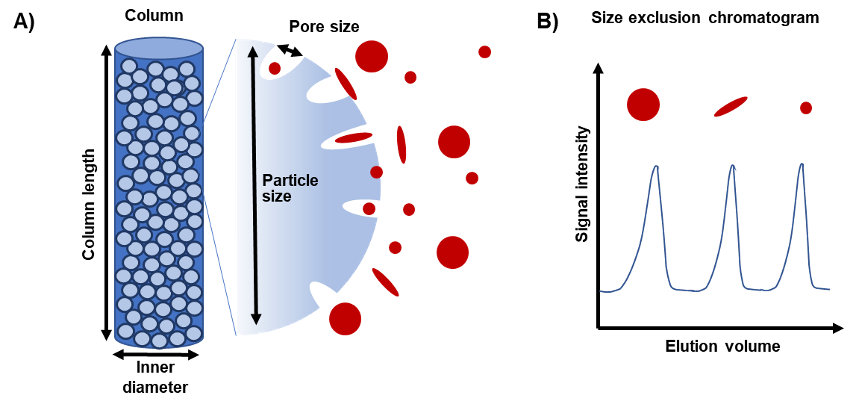 |
| Illustration of a size exclusion column. A) Column with porous particles. B) Exemplary chromatogram of a size exclusion separation. |
How to select an SEC column?
The variety of size exclusion columns is huge and deciding on the right column requires some information on the separation challenge upfront:
- Which molecules do you separate? (size, charge, hydrophobicity, concentration)
- Which conditions are required? (aqueous or organic, temperature)
- How much is separated? (volume and concentration)
- For which purpose? (analytical or purification)
The more is known about the sample and purpose of separation before starting – the easier will be the selection of the column, running conditions and, the method development.
Pore size
The pore size is a crucial characteristic of SEC columns as it dictates how well the column will separate molecules with a particular size and in which size range the column can be used. As a rule of thumb, the pores should be approximately two to three times larger than the largest analyte. If a column is supposed to separate an antibody sample with aggregates (≥10nm), monomer (5 nm) and fragments (≤5nm) a pore size of 25 nm (250 Å) is appropriate.
Some vendors provide calibration curves of their SEC products with different pore sizes which plot molecular weight against the associated elution time (or volume) for differently sized standards. The resulting curves mostly have a steep part for very high and/or very low molecular weights. That means there is no change in the elution time/volume and, hence, no separation despite a change in the molecular weight. In contrast, the shallow part of the calibration curve expresses different retention times at different molecular weights –the column can be used for separating molecules in those MW ranges. When selecting a column with the help of a calibration curve, it is important to pay attention to the calibrants as they should be similar to the analyte. For instance, if a column for protein analysis is searched, the calibration curve should be performed with proteins, whereas for a polysaccharide, a calibration with dextran gives a good indication.
Calibration curves for polymer-based size exclusion columns with different pore sizes and molecule types.
A) PEG and PEO standards B) protein standards |
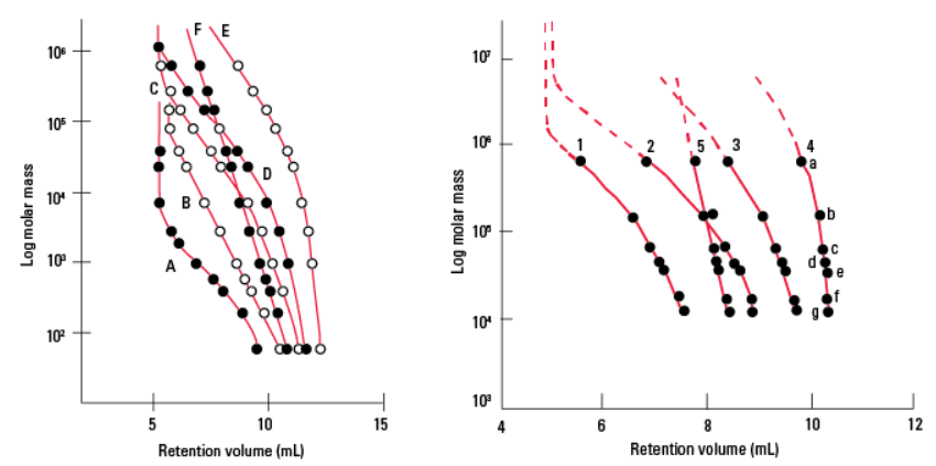 |
Particle size
The particle size describes the average diameter of the small porous spheres which make up the stationary phase packed into the column. It impacts separation efficiency: smaller particles are more efficient (e.g. better resolution, faster separation) due to a smaller mass transfer resistance than larger particles. However, a small particle size increases the backpressure which is generated. The benefits of decreasing particle sizes led to the development of UHPLC columns (particle ≤ 2 µm) and UHPLC instrumentation which can cope with pressures up to 1000 bar.
Influence of the particle size on the plate height (efficiency) of a monoclonal antibody separation |
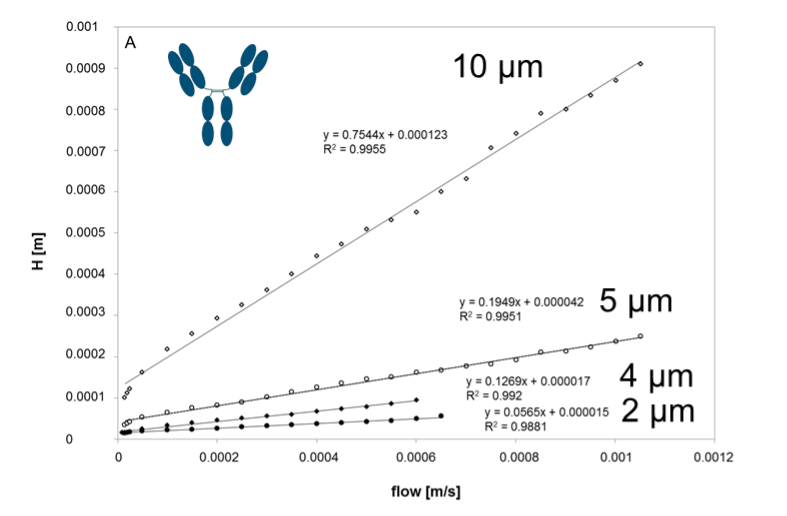 |
| Van-Deemter plot is shown for the monomer of a monoclonal antibody separated on TSKgel columns with identical pore size (25 nm) but different particle sizes ranging from 2 µm – 10 µm |
Base material
Several materials for the stationary phase (the small particles inside the column) of SEC columns are common and they come with different chemical and mechanical properties. These determine which material is the right one for a specific separation. These are the most common base matrices and their advantages and drawbacks.
Overview of base materials for SEC packings and their applications |
| Base material | Advantages | Disadvantages | Suited for |
| Silica | High mechanical stability (stands high pressure) High stability of small porous particles (down to UHPLC size) Highest resolution | Limited pH stability
(pH 2.5 – 8) | Aquaeous conditions (GFC) Biomolecule analysis at physiological pH |
| Polymethacrylate | High pH stability and pressure stability | Larger particles Increased hydrophobicity, leading to secondary interactions | Preparative scale, SEC at high pH |
| PS-DVB | High pH stability High compatibility with organic solvents | High hydrophobicity, potentially strong secondary interactions | Gel permeation chromatography (organic conditions) analysis of polymers |
| Agarose | High pH stability Low secondary interactions | Limited pressure stability Low resolution power Large particle sizes | Preparative scale |
Column dimensions
In general, size exclusion separations benefit from long columns as the number of theoretical plates and thus separation efficiency is linearly correlated with the column length (i.e. double length means double theoretical plates). In contrast, long columns are related to long analysis times. Therefore, a compromise between time and separation performance results in the optimal column length. Low inner diameters of an SEC column reduce the solvent consumption, the total applicable injection volume and increases peak heights which is beneficial for low sample amounts. However, it may be related to increased edge effects during separations.
Common column dimensions for analytical applications
- HPLC: 7.8 mm ID x 30 cm L
- UHPLC: 4.6 mm ID x 30 cm L
- Fast analyses/High throughput UHPLC: 4.6 mm ID x 15 cm L
Quality parameters of SEC columns
Separation performance (Resolution, asymmetry, HETP)
The goal of size exclusion chromatography is the separation of molecule mixtures. Therefore, it is important that molecules are well separated and in a reasonable amount of time. Amongst separation conditions (mobile phase, extra-column dead volume, sample volume), the column itself determines the success of an SEC separation. It is impacted by the particle size, pore volume, packing, secondary interactions (see below) and column length. Different columns are compared by separating a standard sample containing differently sized molecules and a generic method. The data can then be analyzed as to performance parameters such as resolution, asymmetry and plate height. Even though, the approach gives a good indication on the separation performance, the optimal conditions differ between columns which may lead to slightly different results when changing separation conditions.
Lifetime
As an SEC column is a consumable related to costs, it is desired to last for many injections. The number of injections possible to do on a column largely depends on the sample and conditions the column is exposed to. For optimal conditions such as physiological mobile phase conditions, clean and uniform samples, it is possible to use one SEC column for more than 1000 injections.
Lifetime test on the TSKgel UP-SW3000 UHPLC SEC column (reprinted from Graf et al. 2018) |
 |
| SEC chromatograms of repeated injections of a mAb-derived biotherapeutic to determine column lifetime. |
Secondary interactions
Size exclusion is a diffusion-based separation method, which means adsorptive interactions between the stationary phase and sample components interfere with the separation mechanism. Accordingly, a good column is absent of electrostatic and hydrophobic interactions which would lead to retention of some molecules independent of their size. A study published in 2015 compared secondary interactions in different UHPLC SEC columns with the TSKgel UP-SW3000 showing lowest interaction properties (Goyon et al. 2017).
Robustness and reproducibility
A column is robust if its performance (e.g. resolution, retention time) remains unchanged no matter how the column is used, for instance if it is run with high viscosity buffer, with different flow rates or if the flow is stopped intermittently.
Additionally, performance criteria not only have to remain the same under different running conditions, but also when different columns are used (column-to-column reproducibility). Reproducible results need to be obtained no matter when and with which resin a column was packed (lot-to-lot-reproducibility).
Applications of SEC columns
Quality control of protein biotherapeutics – aggregate and fragment analysis in proteins
For the quality control of protein biotherapeutics, the amount of aggregated protein (also referred to as high molecular weight (HMW) impurities) and fragmented protein (also referred to as low molecular weight (LMW) impurities) is analyzed as they alter the pharmacokinetics or efficacy of the drug or increase its immunogenicity. Size exclusion columns separate the larger aggregates from the desired monomeric drug and smaller fragments. With UV-detection, the percentages of impurities and monomer can be determined. An example using HPLC and UHPLC is shown in the Application Note “Comparison of HPLC and UHPLC methods in the quality control of mAb separations by SEC”. Each biotherapeutic has specificationsfor these impurities to make sure the drug is safe and efficient.
Determination of fragment and aggregate impurities in a monoclonal antibody sample
by SEC using an HPLC (G3000SWxl) or UHPLC column (UP-SW3000) |
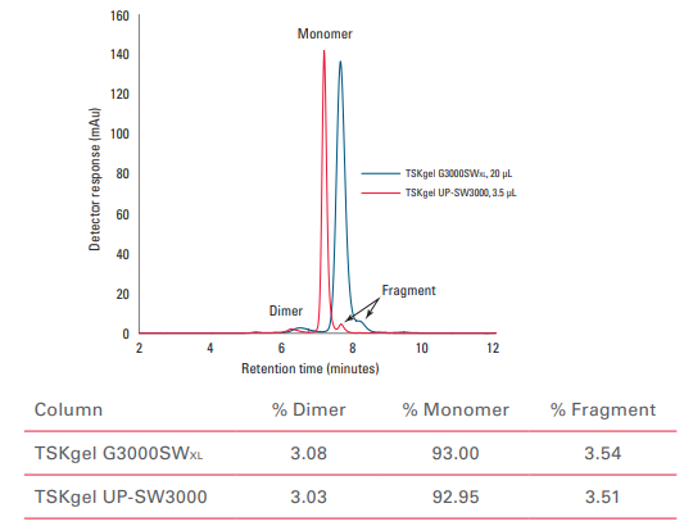 |
Polymer analysis by gel permeation chromatography
Industrial polymers used in coatings, adhesives, plastics, textiles and many more need to characterized as to their molecular mass distribution, co-polymer composition, intrinsic viscosity or polymeric size. In order to separate the differently sized polymers, they need to be present in solution. This often (but not always) requires the use of organic solvents or high temperatures up to 220 °C. Therefore, special GPC columns are resistant to either high organic solvent concentrations and/or high temperatures. Using an SEC column, the polymer solution is separated by size and reveals the size distribution within the sample. Depending on the detection methods used upon separation, different polymer characteristics can be determined. The application note “Monitoring Structural Changes in Polysaccharides using SEC-MALS” shows an example of how linear and coiled structures were differentiated by combining SEC with multi-angle light-scattering (MALS) detection.
Chromatogram of dextran (MW 487 kDa) and pullulan (MW 399 kDa) samples |
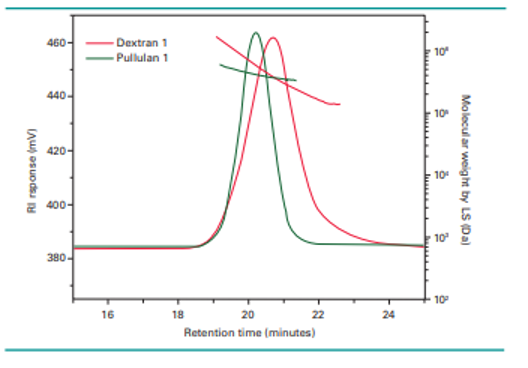 |
References
Graf T et al. (2018) Development of a MultiProduct SE-UHPLC Method for the Determination of Size-Variants in Bispecific Antibody Formats. LCGC North America, LCGC North America-12-01-2018, Volume 36, Issue 12 Pages: 870–879
Goyon A et al. (2017) Evaluation of size exclusion chromatography columns packed with sub-3μm particles for the analysis of biopharmaceutical proteins. J Chromatogr A. 2017 May 19;1498:80-89. doi: 10.1016/j.chroma.2016.11.056.
Further reading: